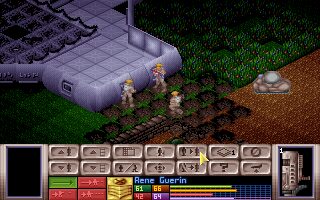Sabre Team is a tactical squad-based strategy game developed originally for the Amiga by Krisalis Software and released in 1992. It was ported to Amiga CD32 and MS-DOS in 1994. The game represents one of the few military tactical simulations designed specifically to take advantage of the Amiga's unique capabilities.
In Sabre Team, players command a four-man Special Air Service unit through various counter-terrorism and hostage rescue missions inspired by real SAS operations. The game combines turn-based tactical planning with real-time action sequences, creating a hybrid approach that was relatively uncommon in early 1990s strategy games. Each team member can be individually controlled and equipped, with different specialists bringing unique skills such as demolitions, medical training, or marksmanship expertise.
What sets Sabre Team apart from other tactical games of the era is its focus on small-unit tactics and close-quarters combat rather than large-scale battlefield management. Unlike contemporaries such as Laser Squad or X-COM: UFO Defense, which deal with alien threats and science fiction scenarios, Sabre Team grounds itself in realistic modern military operations. The game's missions often involve clearing buildings room by room, defusing bombs, and rescuing hostages under strict time constraints, creating intense tactical puzzles that require careful planning and precise execution.
It's immediately apparent that this game was developed for the Amiga, and it's not a PC (possibly with EGA graphics) or an Atari ST port. The graphics effectively convey the tension of indoor combat environments, with detailed building layouts and clear visual feedback for player actions. The sound design particularly excels, using positional audio effects to indicate enemy locations and creating an atmosphere of tactical realism that rivals more famous titles like Rainbow Six, though Sabre Team predates that series by several years.
Compared to other squad-based games like Jagged Alliance or Silent Storm, Sabre Team maintains a tighter focus on realistic military procedures and equipment. While those games incorporate RPG elements and character development, Sabre Team emphasizes pure tactical decision-making and mission execution. The weapon selection feels authentic to actual SAS equipment, and the mission briefings provide genuine tactical intelligence rather than fantasy scenarios.
The game's turn-based movement system allows for methodical planning reminiscent of Rebelstar or early UFO: Enemy Unknown, but the real-time combat resolution adds tension and unpredictability. This hybrid approach influences later tactical games, though few execute it as smoothly as Sabre Team manages within the Amiga's technical constraints.
Mission variety keeps the gameplay engaging, with scenarios ranging from embassy sieges to aircraft hijackings, each requiring different tactical approaches. The game rewards players who study floor plans, coordinate team movements, and use proper breach-and-clear techniques rather than relying on superior firepower alone.
While Sabre Team lacks the broader strategic elements found in games like Combat Mission or Close Combat, its focused approach to small-unit tactics creates a uniquely tense and rewarding experience. Sabre Team's success was limited, but the title remains one of the most authentic tactical military simulations of the early 1990s, offering a level of realism and tactical depth that many later games in the genre would struggle to match.













